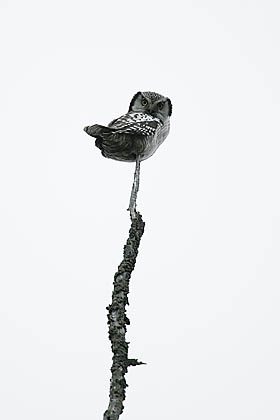Birder’s diary – summary of January
Birder: Margus Ots, linnuvaatleja.ee
Photo: Arne Ader
Translation: Liis
Hawk owl
Bird life in January was strongly influenced by the long drawn-out autumn of last year. Proper winter never arrived in December and even the beginning of January looked more like late autumn in the western islands. In early January the sea had not started to freeze and even the larger inland lakes were still free from ice in the beginning of the year. Because of that there were many waterfowl everywhere, especially on the western islands. Even the waders that generally leave us in November at the latest were seen in the beginning of January in exceptionally many cases. Lapwings (Vanellus vanellus) were observed in several places on the western coast, there were at least three observations of snipes (Gallinago gallinago) in January, 160 plovers (Pluvialis apricaria) were in Keemu (southern shore of Matsalu Bay) in the beginnning of January. The cold wave of the last days has of course set the late migrants moving and the great majority of waterfowl has finally left from here.
In January many passerines, unusual in winter, were seen too. Skylark (Alauda arvensis), wood lark (Lullula arborea), meadow pipit (Anthus pratensis), song thrush (Turdus philomelos) and wagtail (Motacilla alba) observations have been reported, starlings (Sturnus vulgaris) were still seen by flocks. Even a chiff-chaff (Phylloscopus collybita) was observed on January 1st on western Saaremaa; in Viljandimaa a black redstart (Phoenicurus ochruros) was still seen on January 21st.
Of the more exciting winterers at least 5 little grebes (Tachybaptus ruficollis) , 4 moorhens (Gallinula chloropus) and 4 cranes (Grus grus) have been seen. Such numbers of these species have not been observed in Estonia in earlier winters. Information about the most exciting finds is on the Estbirding web page and in the e-Biodiversity data base.
Of rarities and aberrants the grey phalarope (Phalaropus fulicarius) (found on December 31st and seen in the same place until January 3rd) was seen in the beginning of January at Laoküla beach in Harjumaa, the hawk owl (Surnia ulula) was seen in two places - Vormsi island and Valmaotsa in Tartumaa, the glaucous gull (Larus hyperboreus) was seen in Paldiski and the snowy owl (Bubo scandiacus) in Kärkna in Tartumaa. Winter “rarity owls“ were actually seen surprisingly seldom, we had at least hoped to see the hawk owl more often. But the first rarities of the year have been found and the first points in the Rarileidja 2012 contest arranged by Estbirding have been distributed.
105 bird species were collected to my 2012 species list in the first month of the year. I should point out once more that this is far from an exceptional result. In 2009 for instance the best birders had collected 100 species already on January 3-4. It would have been possible to repeat or surpass this particular record this year but my aim is to see as many species as possible during the whole year, and a rush attack in the beginning of the year was not on the agenda. Many quite common species are missing on my year list (for instance tawny owl, Ural owl, grey-headed woodpecker, hazel grouse) but there is no need to worry about them, on the springtime trips I will certainly meet them many times. I have rather concentrated on looking for rare and difficult to find species. In the species list are already heavyweight species such as the grey phalarope (Phalaropus fulicarius) (twitched on January 1st in Laoküla), glaucous gull (Larus hyperboreus) (found on January 28th in Paldiski), hawk owl (Surnia ulula) (twitched at Valmaotsa), eagle owl (Bubo bubo) (2 observations), Arctic redpoll (Carduelis hornemanni) (2 observations); on top of that I have seen the “obligatory“ Saaremaa winter species Steller’s eider (Polysticta stelleri) and purple sandpiper (Calidris maritima) too. But of the winter species I still have not seen the twite (Carduelis flavirostris) (only one observation known in January), snowy owl (Bubo scandiacus) (only 1 observation reported, the bird could not be twitched) and the pine grosbeak (Pinicola enucleator) (no observations known yet in Estonia this winter). Summing up, there have been no serious set-backs in the year list enterprise, and there are several months left yet to find the missing winter species.









